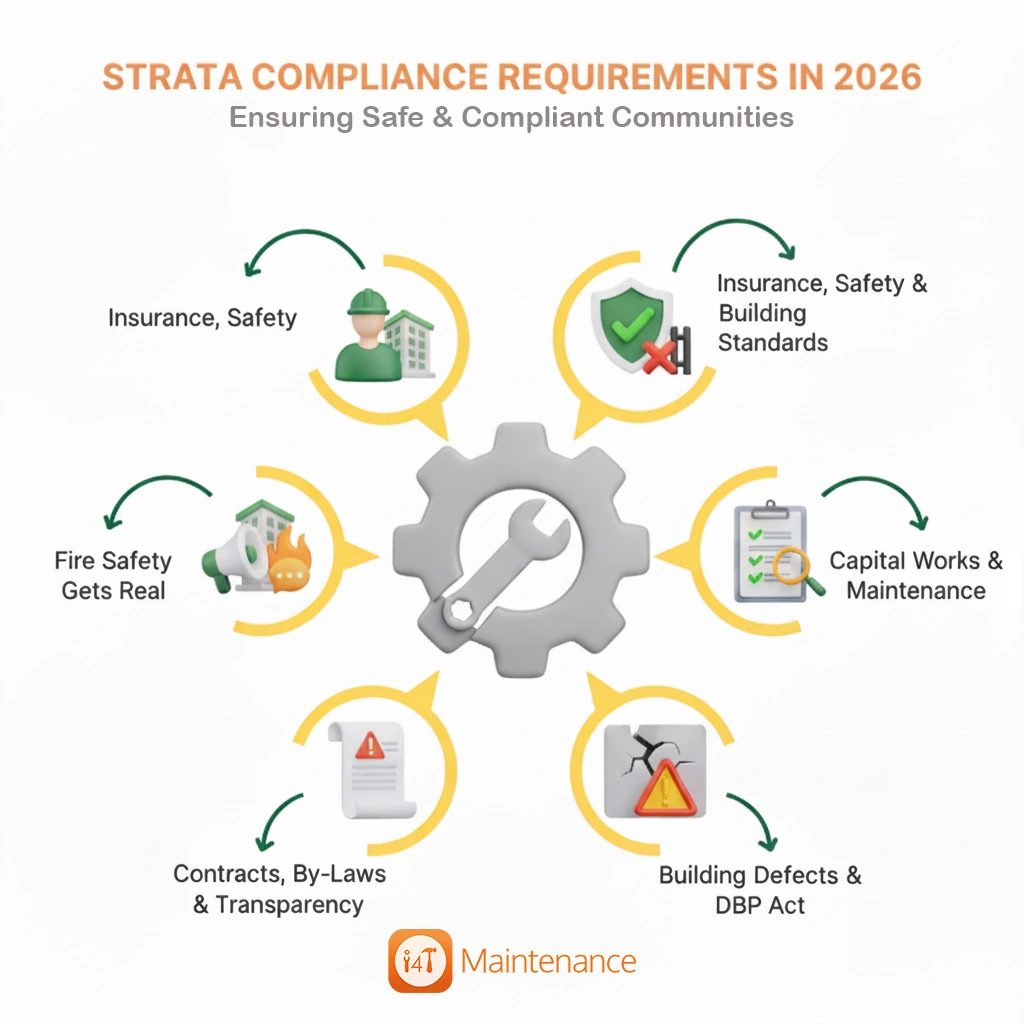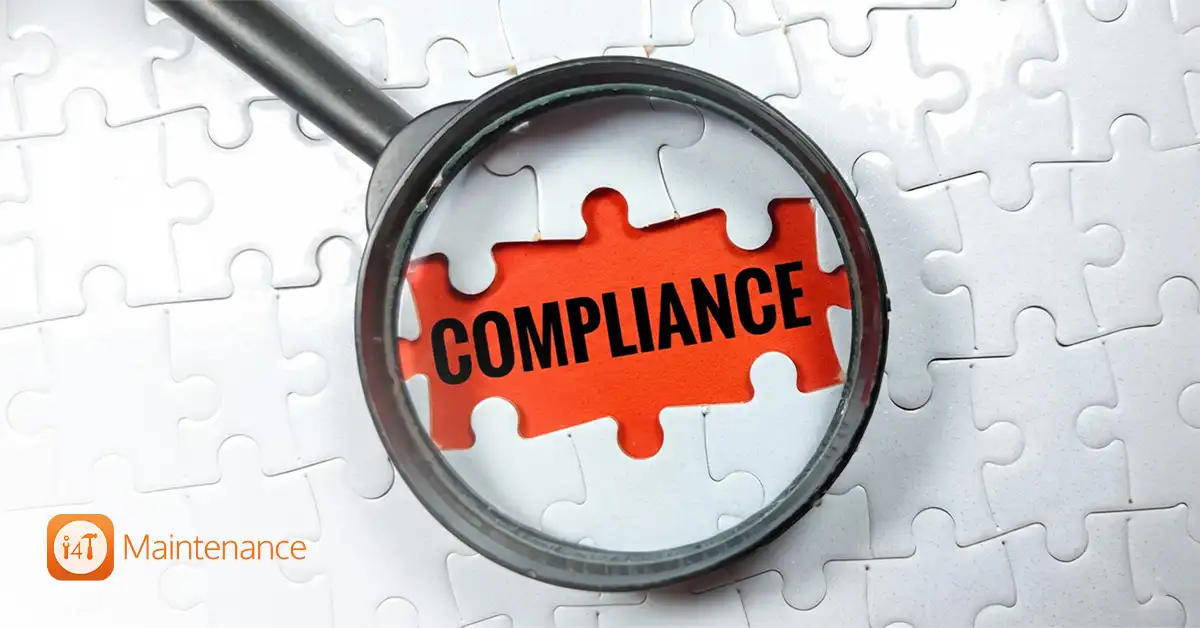In Short
In 2026, Australian strata buildings will need to meet tougher rules around fire safety (AS 1851), capital-works planning, building-defect management (DBP Act), transparent contracts, and accurate record-keeping.
The big deadlines: February 2026 for new fire-safety servicing standards and April 2026 for the new capital-works-plan format.
Every strata committee will need to prove inspections are done, documents are stored properly, and contractors are qualified, or risk fines and major headaches.
The Evolving Strata Regulation Landscape
If you’ve ever been part of a strata committee, you already know that managing shared property can feel like running a small business minus the pay, plus a whole lot of rules.
And 2026? It’s shaping up to be a milestone year for strata compliance across Australia.
Why? Because governments have been tightening laws to make buildings safer, more transparent, and better managed after years of fire safety scares, defect dramas, and maintenance confusion.
Each state has its own strata laws, NSW, Victoria, Queensland, and so on, but 2026 brings changes that ripple right across the country, especially through national standards like AS 1851 and the Design and Building Practitioners (DBP) laws.
Strata compliance is levelling up, and every strata manager and Owners Corporation needs to keep up.

The Key Strata Compliance Areas for 2026
Let’s break down what’s actually changing, and what your strata committee needs to do about it.
Fire Safety Gets Real – AS 1851 and AFSS Rules
From 13 February 2026, all NSW strata buildings must follow AS 1851-2012, the national standard for maintaining fire protection systems.
That means:
- More frequent inspections (some monthly instead of yearly).
- Every missed service must be recorded.
- All records must be kept for seven years, and ideally stored on-site or digitally.
- From February 2027, only accredited fire-safety practitioners can sign off your Annual Fire Safety Statements (AFSS).
Fires don’t give warnings. Keeping extinguishers, alarms, sprinklers and hydrants up to code keeps everyone safe and keeps your insurance valid.
What can you do today:
- Book a fire-safety audit before the 2026 rule change.
- Ask your contractor if they’re compliant with AS 1851.
- Switch to a digital logbook for inspections and certificates.
- Budget for the extra servicing, it’ll pay off in peace of mind.
Capital Works & Maintenance Plans Get a Makeover
From 1 April 2026, all new or updated 10-year capital works fund plans in NSW must use a new standard format.
That might sound boring, but it’s actually great news; it makes planning clearer and easier to compare.
For new strata schemes, there are extra requirements too:
- You’ll need a proper Initial Maintenance Schedule (IMS).
- If it’s a multi-storey building, the levy estimates must be independently certified by a surveyor.
- Developers face tougher penalties for skipping AGMs or failing to hand over documents on time.
The government wants buildings to plan properly for repairs, replacements and upgrades, so no one gets stuck with massive surprise bills later.
What strata managers need to do:
- Review your current plan to make sure it’s ready for the 2026 format.
- Use the update as a chance to include sustainability projects like EV chargers or solar panels.
- Keep levies realistic; cheap now often means expensive later.
Contracts, By-Laws & Transparency
Strata isn’t just about concrete and tiles; it’s about people, money and trust. That’s why 2026 brings stricter rules to keep contracts fair and committees accountable.
Key updates:
- From 1 July 2025, contracts must not contain unfair terms (thanks to national consumer laws).
- Strata managers and building managers must disclose any commissions, benefits or supplier links.
- By-laws that give special privileges, like exclusive car spaces or garden areas, must have owner consent, and that consent can’t be unreasonably refused.
- Strata committees will soon need to complete basic training to make sure they understand their responsibilities.
No more dodgy deals. Owners Corporations can expect clearer, fairer agreements and fewer disputes.
What Owners Corporations and strata managers need to do:
- Review your current service contracts (cleaning, landscaping, maintenance, management).
- Add disclosure clauses if missing.
- Update by-laws for exclusive-use areas and maintenance duties.
- Keep a simple “governance register” of all agreements and renew it yearly.
Building Defects & the DBP Act
The Design and Building Practitioners (DBP) Act has already shaken up the construction world, and from 1 July 2026, its reach will expand even further.
That means:
- Any major remedial or alteration work on certain building types (Class 2, 3, 9C) will need certified design documents lodged through the NSW Planning Portal.
- Only registered practitioners can design or certify those works.
- Some insurance requirements for building professionals will kick in from mid-2026.
If your building is undergoing any renovation, even fixing defects or upgrading balconies, the DBP Act could apply. Non-compliance can delay approvals, void certificates, or even trigger legal action.
What do owners’ corporations need to consider:
- Ask your builder or engineer if your project is DBP-covered.
- Make sure they’re on the official DBP register.
- Keep every design, declaration and certificate filed properly.
- Never start work without a set of plans; it’s not worth the risk.
Record-Keeping & Reporting
If your strata’s paperwork lives in a shoebox or an inbox, 2026 is your year to clean up. New rules are making digital record-keeping and reporting a must-have, not a maybe.
What’s changing:
- From July 2025, inspection fees are going up (so if you’re charging or paying for access to records, check the new rates).
- From October 2025, strata managers must issue regular reports covering maintenance, finances and contractor performance.
- From April 2026, strata and community schemes will have aligned record rules, meaning digital access, faster responses, and longer retention times.
What best practices should strata managers adopt?
- Keep all records (minutes, by-laws, fire logs, contracts, insurance) in a cloud system with backups.
- Store fire-safety documentation for at least seven years.
- Provide easy access to committee members and authorised auditors.
- Produce a simple annual “compliance snapshot” for owners – what’s been done and what’s next.
Your future self (and your future committee) will thank you.
Insurance, Safety & Building Standards
Compliance doesn’t stop with paperwork. Your insurance, safety procedures and building standards also need to be on point.
Key things strata managers need to stay on top of:
- Insurance valuations should be reviewed every 3–5 years to avoid under-insurance.
- Your policy should clearly cover fire, water, public liability, and defect risks.
- Work Health & Safety (WHS) applies to common property, which means safe lighting, handrails, electricals, pool fences, and lifts.
- Any building works or upgrades must comply with the National Construction Code (NCC 2025), which includes new standards for energy efficiency and accessibility.
- Always use licensed contractors and keep copies of their licences and insurance.
A safe building isn’t just compliant; it’s comfortable, respected and more valuable.
How to Actually Stay Compliant
Here’s your 7-step plan for turning 2026 compliance from a headache into a system that works for you.
Step 1: Audit Everything
Do a full audit. List every certificate, contract, and deadline. Identify gaps and expired items.
Step 2: Create a 12-Month Action Plan
Write a simple plan covering key milestones (Feb 2026 – fire safety, Apr 2026 – capital works).
Assign tasks to individuals to get things done.
Step 3: Budget Smart
Build compliance costs into your levies, especially extra inspections, digital systems, and reports.
Step 4: Work With the Right People
Hire accredited contractors who know the 2026 standards. Ask for proof of registration, licences, and insurance, then keep them on file.
Step 5: Go Digital
Paper folders are so 2010. Use a maintenance management platform like i4T Maintenance to track work orders and document compliance automatically.
Step 6: Educate Your Owners
Hold a quick info night or send a friendly newsletter explaining why compliance matters.
People support what they understand.
Step 7: Review Every Year
At each AGM, table a compliance summary. What got done? What’s due? What needs funding?
When you make compliance a routine, surprises disappear.
How to Avoid Common Strata Compliance Hiccups
Even the best-run strata schemes trip up sometimes. Remember, compliance is easier (and cheaper) when you stay organised.
Here are the most common issues and how to dodge them:
| Problem | Fix It This Way |
|---|---|
| Too many rules to keep track of | Centralise everything in one compliance checklist or app |
| Rising costs | Get multiple quotes, spread costs over levy cycles |
| Volunteer burnout | Share the load, or hire admin help via your strata manager |
| Owners pushing back on levies | Explain how compliance saves money long-term and avoids fines |
| Forgetting deadlines | Use calendar reminders or automated alerts |
| Lost paperwork | Move everything online and back it up |
The Benefits of Keeping Up with Strata Compliance Requirements
Yes, compliance can feel tedious, but the payoff is huge.
- Safer homes – fewer accidents, fewer fires, fewer insurance issues.
- Protected investments – buildings with clean records attract buyers.
- Happier communities – fewer disputes when everything’s clear and fair.
- Lower long-term costs – planned maintenance beats emergency repairs.
- Sustainability gains – better planning opens doors to energy-efficient upgrades.
When a strata is compliant, it runs smoothly, residents trust each other more, and everyone sleeps better at night.
Over to you
When it comes to strata compliance requirements, 2026 isn’t about more red tape; it’s about raising the standard for safer, fairer, better-managed buildings. If you start preparing now, you won’t just avoid trouble, you’ll make your strata community stronger and easier to run.
Once the right systems are in place, the rest runs like clockwork, saving time, money and stress.
If you’d like to take the hassle out of strata compliance, try i4T Maintenance – a user-friendly strata maintenance management software built to help strata managers and committees:
- Track maintenance work orders automatically
- Request multiple suppliers’ quotes.
- Manage contractor licences and insurance
- Documents and stores all work to keep records audit-ready.
Stay ahead of every rule change, avoid missed deadlines, and make your 2026 compliance journey easy. Explore i4T Maintenance today, and enjoy peace of mind knowing your strata is always compliant, organised and future-ready.
FAQs
From 2026, key rules cover fire safety (AS 1851), capital works planning, building defect management, record-keeping, and transparent contracts for strata schemes.
The AS 1851 fire servicing rules start on 13 February 2026 in NSW, with mandatory monthly checks for some systems and seven-year record retention.
AS 1851-2012 is the Australian Standard for routine servicing of fire protection systems, setting out how and when to inspect, test and maintain them.
Non-compliance can lead to fines, loss of insurance cover, legal disputes, or orders to fix issues at the Owners Corporation’s cost.
From 1 April 2026, NSW strata schemes must use a new government-approved format for 10-year capital works plans and initial maintenance schedules.
Yes. Reforms will introduce mandatory training for committee members to ensure they understand governance and compliance duties.
Most records must be stored for at least seven years, including fire-safety documents, contracts and financial statements.
The Design and Building Practitioners (DBP) Act requires registered practitioners to design, declare and certify certain building works, ensuring higher construction quality and accountability.
Use digital tools like i4T Maintenance to track inspections, store records, manage contractors, and get automatic reminders for deadlines.
It protects safety, property value and peace of mind. A compliant building runs smoothly, avoids penalties and earns buyer confidence.

